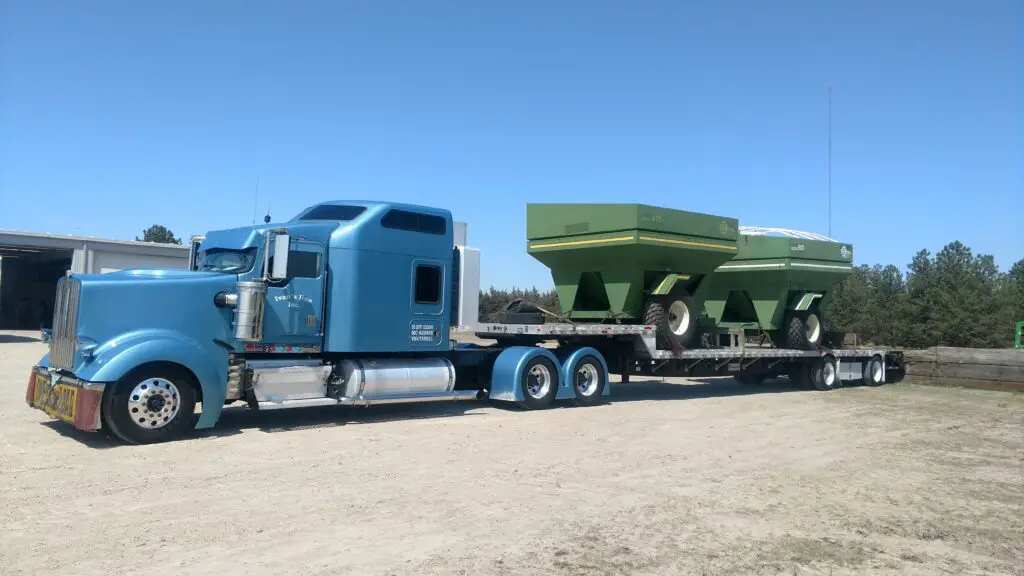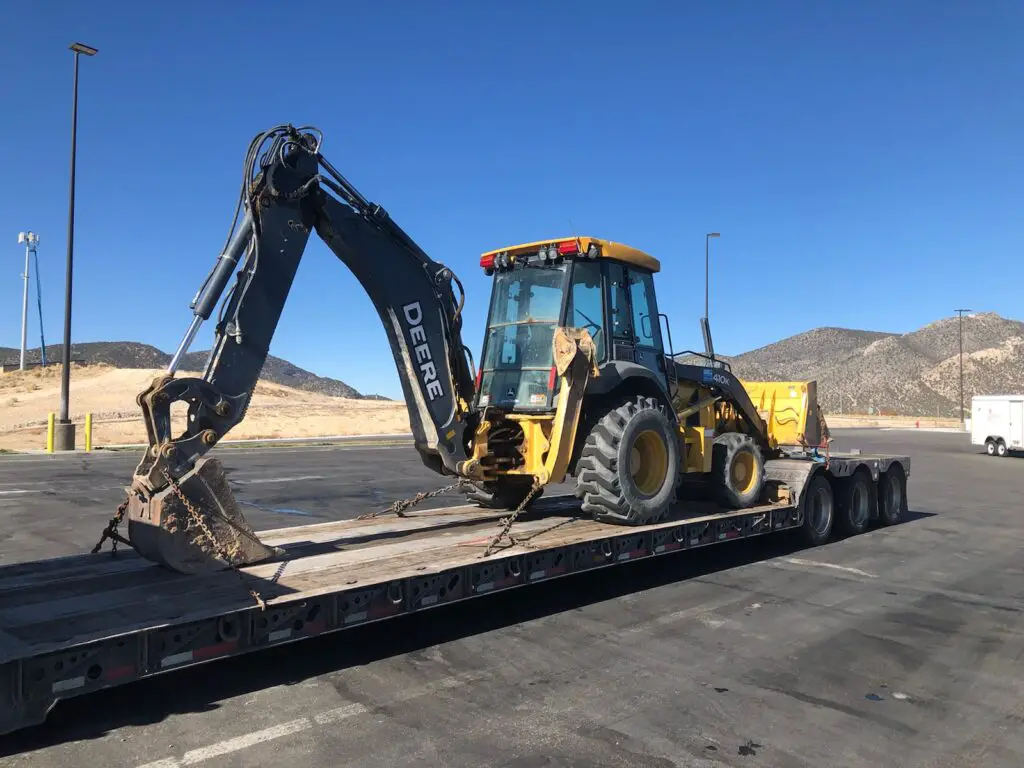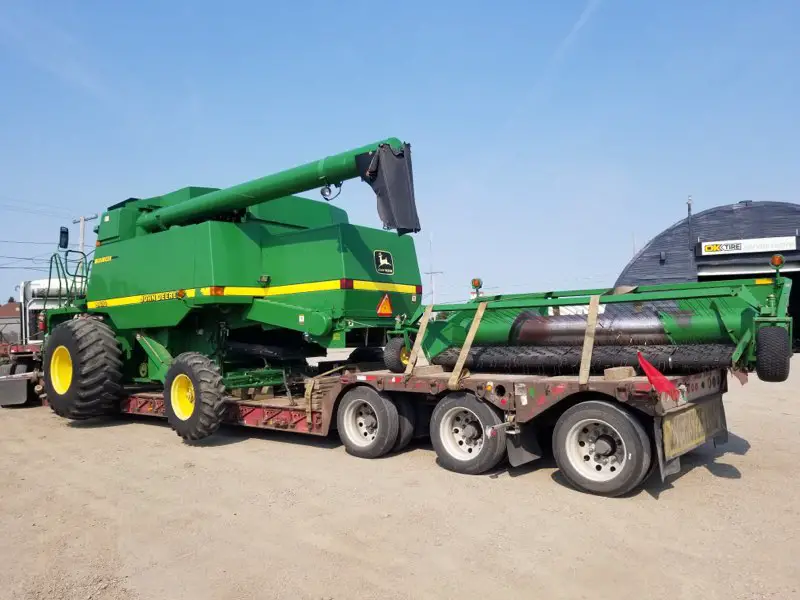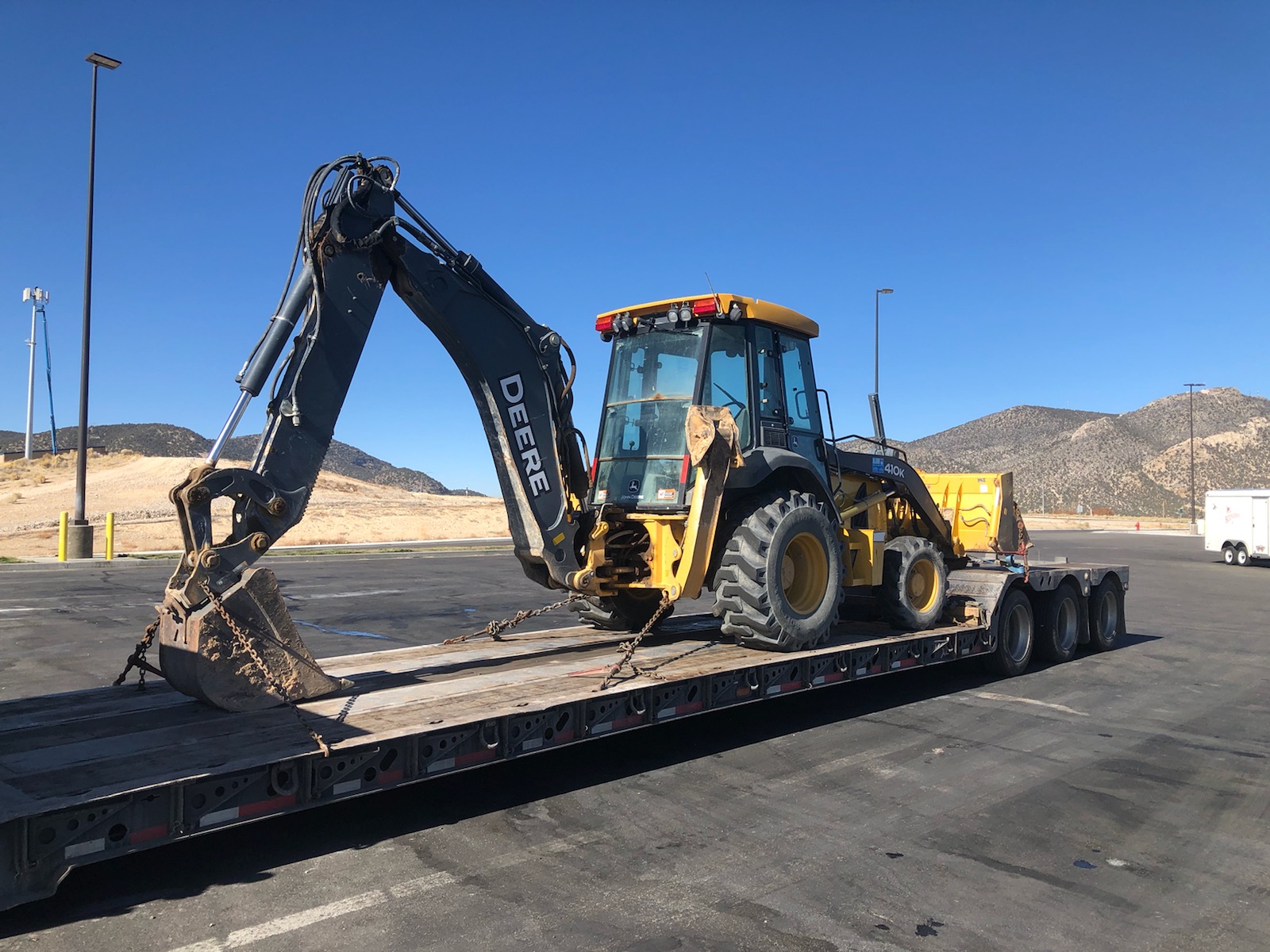This post may contain affiliate links which means I may receive a commission for purchases made through links. Learn more on my Private Policy page.
If you’re a farmer or involved in the agricultural industry, you understand the challenge of transporting heavy farm equipment. From tractors and harvesters to plows and hay balers, getting these massive machines from one place to another requires careful planning and strategy. In this article, we’ll explore the best ways to transport heavy farm equipment, considering aspects like distance, safety, and cost-effectiveness. Whether you’re moving equipment across town or to a different state, we’ve got you covered with practical tips and expert advice to make your transportation journey a smooth one.

This image is property of www.tractortransport.com.
Factors to Consider Before Transporting Heavy Farm Equipment
Before transporting heavy farm equipment, there are several factors that you need to take into consideration. By being thorough in your planning and preparations, you can ensure a smooth and safe transportation process.
Determining the type and size of equipment
The first step in preparing for transportation is to determine the type and size of the farm equipment. This will help you assess the requirements for transportation, such as the weight and dimensions of the equipment. Identifying the specific equipment will also help you decide on the most suitable transportation method. For instance, larger equipment may require a lowboy trailer, while smaller equipment can be transported on a flatbed truck.
Checking the weight restrictions
Once you have determined the type and size of the equipment, it is crucial to check the weight restrictions of the transportation method you plan to use. Each transportation method has its own weight limits, and exceeding these limits can lead to serious safety concerns. By ensuring that your equipment falls within the weight restrictions, you can prevent any potential accidents or damage to the equipment during transportation.
Choosing the right transportation method
Choosing the right transportation method is essential to ensure the safe and efficient transportation of heavy farm equipment. Flatbed truck transportation is commonly used for smaller equipment that can be securely loaded and transported on a flat surface. Lowboy trailer transportation is ideal for large and heavy equipment, as it offers a lower deck height that allows for easier loading and unloading. Alternatively, step deck trailer transportation is suitable for equipment that is taller or has taller attachments, as it has a lower profile in the front and a higher profile in the rear. Evaluate the equipment’s size and the transportation options available to determine the best method for your specific needs.
Preparing the Equipment for Transport
Preparing the equipment for transport is a critical step to ensure its safety during transportation. By performing a thorough inspection and taking necessary precautions, you can minimize the risk of damage and ensure a smooth transport process.
Performing a thorough inspection
Before transporting heavy farm equipment, it is important to conduct a thorough inspection. Check for any existing damage or signs of wear and tear. Inspect the tires, hydraulics, and any other crucial components of the equipment. Identifying any issues beforehand will allow you to address them or make necessary repairs before transportation, reducing the likelihood of further damage during transit.
Dismantling or securing loose parts
To prevent any damage or loss of parts during transportation, it may be necessary to dismantle or secure loose parts on the farm equipment. Remove detachable components, such as small attachments or accessories, and store them separately. Secure any loose parts that cannot be removed to minimize the risk of damage during transit. This will help ensure that the equipment arrives at its destination in the same condition it was in before transport.
Draining fluids and removing detachable components
Before transporting heavy farm equipment, it is crucial to drain fluids such as fuel, oil, and hydraulic fluids. This is important for two reasons: safety and compliance. Draining fluids reduces the risk of leaks or spills during transportation, which can be hazardous. Additionally, it ensures compliance with transportation regulations, as certain fluid levels may exceed the allowed limits. Remember to also remove any detachable components, such as batteries or windshield wipers, and secure them separately during transportation.
Transportation Methods for Heavy Farm Equipment
When it comes to transporting heavy farm equipment, there are several transportation methods available. Each method has its own advantages and considerations, so it is important to choose the one that best suits your needs.
Flatbed truck transportation
Flatbed truck transportation is a popular choice for smaller farm equipment. The equipment is loaded onto a flatbed truck, which provides a stable and secure platform for transportation. Flatbed trucks offer ease of loading and unloading, as the equipment can be driven or rolled onto the truck. However, it is important to ensure that the equipment is properly secured to the truck to prevent any movement or damage during transit.
Lowboy trailer transportation
For larger and heavier farm equipment, lowboy trailer transportation is often the preferred option. Lowboy trailers have a lower deck height, allowing for easy loading and unloading of tall or heavy machinery. The lower height also offers added stability during transportation. However, due to the specialized nature of lowboy trailers, it is essential to have the equipment properly secured and balanced to ensure safe transportation.
Step deck trailer transportation
Step deck trailer transportation is suitable for farm equipment that is taller or has taller attachments. These trailers have a low profile at the front and a higher profile at the rear, allowing for the transportation of taller equipment. The stepped design accommodates the height of the equipment while maintaining stability throughout the journey. As with any transportation method, it is important to secure the equipment properly and ensure even weight distribution to prevent any accidents or damage.
Hiring Professional Equipment Transporters
While transporting heavy farm equipment on your own may seem like a cost-effective option, it is often best to hire professional equipment transporters. Professional transporters have the experience, expertise, and specialized equipment necessary to handle heavy farm equipment securely and efficiently.
Researching and comparing different transport companies
When hiring professional equipment transporters, take the time to research and compare different transport companies. Look for companies that have experience in transporting heavy farm equipment and have a good reputation in the industry. Consider factors such as their track record, customer reviews, and the types of equipment they specialize in transporting. By doing thorough research, you can ensure that you choose a reliable and reputable transporter.
Checking for proper licensing and insurance
Before hiring a professional equipment transporter, verify that they have the proper licensing and insurance in place. Check if the transporter holds the necessary permits and licenses required for transporting heavy equipment in your area. Additionally, ensure that they have appropriate insurance coverage for the equipment being transported. This will provide you with peace of mind knowing that you are working with a legitimate and insured transporter.
Reading customer reviews and references
Customer reviews and references are valuable resources when hiring professional equipment transporters. By reading reviews from previous customers, you can gain insights into the transporter’s level of service, reliability, and professionalism. Additionally, ask for references from the transport company and reach out to their past clients to inquire about their experiences. This will help you make an informed decision and select a transporter that meets your specific needs.

This image is property of www.tractortransport.com.
Legal Requirements and Permits for Heavy Farm Equipment Transport
Transporting heavy farm equipment involves complying with legal requirements and obtaining the necessary permits. Familiarize yourself with the regulations and ensure that you meet all the legal obligations to avoid any penalties or delays during transportation.
Understanding weight and dimensions regulations
Different jurisdictions have varying weight and dimension regulations for transporting heavy equipment. It is crucial to understand and comply with these regulations to ensure a legal transport. Factors such as axle weight limits, vehicle length, and height restrictions may affect your transportation plan. By familiarizing yourself with the regulations in your area, you can plan your transport route accordingly and avoid any legal issues.
Obtaining necessary permits and escorts
In addition to complying with weight and dimension regulations, you may need to obtain special permits and escorts for transporting heavy farm equipment. Some equipment may exceed the standard limits and require oversize/overweight permits. Depending on the size and weight of the equipment, you may also need to arrange for escorts or pilot vehicles to accompany the transport. These measures ensure the safety of both the equipment being transported and other road users.
Complying with state and federal transportation laws
In addition to local regulations, you must also comply with state and federal transportation laws. Research and familiarize yourself with these laws to ensure that you are fully compliant during transportation. Examples of federal regulations include the Federal Motor Carrier Safety Regulations (FMCSR) administered by the U.S. Department of Transportation. By adhering to these laws, you can ensure a legal and safe transportation process.
Securing and Protecting Equipment during Transportation
During transportation, it is crucial to secure and protect the equipment to prevent damage or accidents. By taking appropriate measures, you can ensure that the equipment arrives at its destination in the same condition it was in before transport.
Using appropriate tie-downs and chains
Properly securing the heavy farm equipment is essential to prevent shifting, sliding, or any other movement during transportation. Use appropriate tie-downs, chains, or straps to secure the equipment to the transportation vehicle. Make sure the tie-downs are in good condition and are capable of withstanding the weight and movement of the equipment. Additionally, double-check the tension of the tie-downs periodically during transportation to ensure that they remain secure.
Ensuring proper weight distribution
Maintaining proper weight distribution is crucial for safe transportation. Improper weight distribution can lead to instability, increased wear and tear on the equipment, and potentially, accidents. Distribute the weight evenly on the transportation vehicle, paying attention to the equipment’s center of gravity. This will help maintain stability and minimize the risk of tipping or other accidents during transportation.
Protecting from weather and road debris
During transportation, heavy farm equipment is exposed to various external factors such as weather conditions and road debris. To protect the equipment, consider covering it with tarps or weatherproof covers. This will shield the equipment from rain, snow, and other weather elements that could cause damage. Additionally, take precautions to minimize the risk of road debris hitting the equipment during transit. Consider using mud flaps or other protective measures to prevent any potential damage.

This image is property of www.shiply.com.
Choosing the Right Route
When transporting heavy farm equipment, it is important to choose the right route to ensure a safe and efficient journey. Consider various factors when planning your route to avoid any obstacles or hazards.
Considering road and bridge weight limits
Road and bridge weight limits are critical to consider when planning your transportation route. Exceeding these limits can result in fines, damage to the equipment, or even collapse of the infrastructure. Take time to research and identify any weight restrictions along your planned route. Plan an alternative route if necessary to ensure compliance with these limits and prevent any potential complications.
Avoiding low-clearance obstacles
Low-clearance obstacles such as bridges or tunnels can pose a significant challenge when transporting heavy farm equipment. Before beginning the journey, identify and avoid any low-clearance areas along your route that could potentially hinder or damage the equipment. Utilize resources such as GPS navigation systems, maps, or specific route planning services to ensure that you select a route that avoids such obstacles.
Verifying the condition of roads and bridges
Before embarking on your journey, verify the condition of the roads and bridges along your planned route. Check for any road closures, construction zones, or other potential obstacles that could affect the transportation of heavy equipment. Regularly monitor traffic and weather conditions to ensure a safe and efficient transportation process. By staying informed and adapting your route accordingly, you can minimize risks and delays.
Safety Tips for Transporting Heavy Farm Equipment
Ensuring safety during the transportation of heavy farm equipment should be a top priority. By following these safety tips, you can minimize the risk of accidents and ensure a safe journey.
Maintaining proper visibility during transportation
Maintaining proper visibility is crucial for safe transportation. Ensure that the driver of the transportation vehicle has an unobstructed view of the road and surrounding areas. Remove any unnecessary equipment or obstacles that may impede visibility. Additionally, utilize mirrors and other aids to minimize blind spots and maximize visibility.
Observing speed limits and traffic regulations
Adhering to speed limits and traffic regulations is essential for the safety of everyone on the road. Keep in mind that heavy farm equipment may require slower speeds due to their size, weight, and slower acceleration. Additionally, always obey traffic laws, including using turn signals and properly yielding to other vehicles. By being a responsible and cautious driver, you can help prevent accidents and ensure a safe transportation process.
Using caution during loading and unloading
Loading and unloading heavy farm equipment can be a potentially hazardous task. Use caution and follow proper procedures to avoid accidents or injuries during these processes. Ensure that the equipment is securely fastened and properly balanced before loading and unloading. Use appropriate equipment, such as ramps or crane systems, to facilitate safe and efficient loading and unloading. If necessary, seek assistance from trained professionals to ensure that these tasks are carried out safely.

This image is property of comparethecarrier.com.
Insurance Coverage and Liability
When transporting heavy farm equipment, it is important to review your insurance policies and understand the liability responsibilities. By being adequately insured and aware of your responsibilities, you can mitigate any potential financial risks.
Reviewing insurance policies and coverage
Before transporting heavy farm equipment, review your insurance policies to confirm whether they provide adequate coverage for any potential damage or loss during transportation. Contact your insurance provider to discuss the specific details of your transportation plan and clarify any uncertainties regarding coverage. Ensure that you are properly insured to avoid any unexpected financial burdens.
Understanding liability responsibilities
Understanding your liability responsibilities is essential when transporting heavy farm equipment. Clarify who will be responsible for any damage or accidents that may occur during transportation. This includes liability for damages to the equipment being transported, damages to third-party property, injury to individuals, and any other liabilities that may arise. By understanding your responsibilities, you can ensure that you are prepared for any potential issues that may arise.
Obtaining additional insurance if necessary
If your existing insurance policies do not provide adequate coverage for the transportation of heavy farm equipment, consider obtaining additional insurance. Consult with your insurance provider to explore options for additional coverage specific to the transportation of heavy equipment. While this may involve an additional cost, it can provide valuable protection and coverage in case of any unforeseen incidents.
Tips for Off-loading and Assembly at the Destination
After successfully transporting heavy farm equipment to its destination, there are additional considerations for off-loading and assembly. By following these tips, you can safely and efficiently complete the process.
Having a plan for unloading and assembly
Before arriving at the destination, have a clear plan for unloading and assembly. Identify the designated area where the equipment will be off-loaded and determine the required steps for assembly. Ensure that the off-loading area is clear and accessible, allowing for safe and convenient unloading procedures. By having a well-thought-out plan, you can streamline the unloading and assembly process at the destination.
Using appropriate equipment and tools
The unloading and assembly process may require the use of specific equipment and tools. Ensure that you have the necessary equipment and tools readily available. This includes items such as forklifts, cranes, or specialized tools required for assembly. Use the appropriate equipment and tools to prevent any damage to the equipment or potential injuries during the process.
Ensuring safety during the process
During the off-loading and assembly process, prioritize safety to prevent any accidents or injuries. Communicate effectively with the individuals involved in the process, providing clear instructions and maintaining a safe distance from moving equipment. Follow proper safety protocols, including the use of personal protective equipment (PPE) when required. By prioritizing safety, you can ensure a successful completion of the off-loading and assembly process.
Transporting heavy farm equipment requires careful planning, meticulous preparation, and adherence to legal requirements. By considering the factors mentioned above, such as selecting the right transportation method, securing the equipment properly, and following safety guidelines, you can ensure a safe and successful transportation process. Whether you choose to transport the equipment yourself or hire professional equipment transporters, prioritize safety, and take the necessary precautions to protect both the equipment and those involved in the transportation.

This image is property of www.trusteddispatch.com.
This post may contain affiliate links which means I may receive a commission for purchases made through links. Learn more on my Private Policy page.

